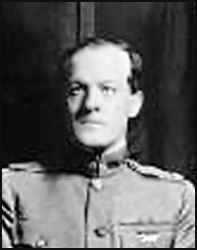
1880-1967 |
 |
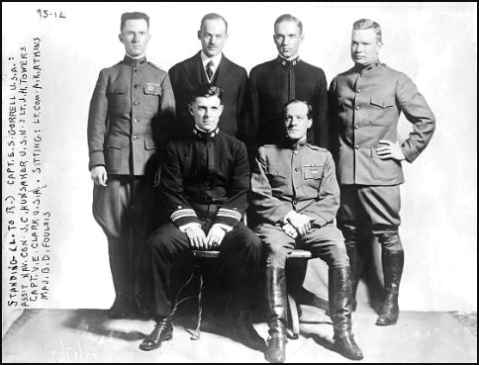 |
|
STANDING (L. TO R.) CAPT. E.S. GORRELL U.S.A.; ASS'T NAV. CON. J.C. HUNSAKER U.S.N.; LT. J.H. TOWERS CAPT. V.E. CLARK U.S.A. - SITTING: LT. COM. A.K. ATKINS MAJ. B.D. FOULOIS |
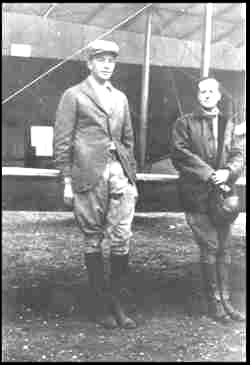 |
|
Courtesy of David Balanky |
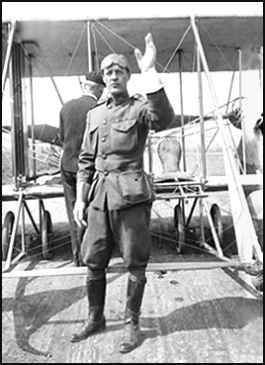 |
|
|
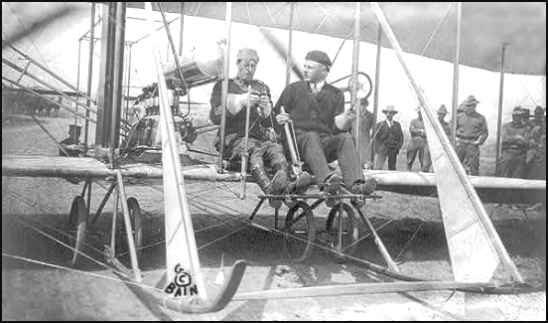 |
|
|
|
Foulois, later a brigadier general, recalled that when he was ordered to Fort Sam Houston, Texas, with Signal Corps aeroplane No. 1 to teach himself to fly, he was admonished to take along "plenty of spare parts." On that machine he had his first solo flight, first takeoff, first landing and first crackup---thereafter receiving instruction from the Wright brothers by mail whenever he needed advice on some as yet obscure aspect of becoming a pilot. This premier military plane remained in active service until 1911; it now shares honors with other early aircraft in the National Air and Space Museum in Washington. A plaque on the parade ground at Fort Meyer commemorates the 1909 trials. |
|
Early Bird Benny Foulois brought his 1st Aero Squadron to Columbus to provied the "eyes" for General Black Jack Pershing's Punitive Expedition, which had been ordered to pursue Villa and bring him back, dead or alive. (They never caught him.) Foulois had 10 other aviators with him, including two who also became members of the Early Birds, Herbert Dargue and Edgar Gorrell. They first flew Curtiss JN3s, actually modified NJ2s, then Curtiss N-8s and finally Curtiss R-2s. None proved suited to military operations in the arid southwest, however. While the exercise appeared to be a disaster in one sense, it marked a turning point in military aviation. It was the first time ever that an American tactical air unit would be tested in the field under combat conditions. The 1st Aero, then the Army Signal Corps' only flying arm, flew hundreds of reconnaissance, photo and courier missions. And when it ended, Benny had demonstrated that the airplane was no longer an experiment or novelty, but a practical tool with many use military applications. Each year Columbus commemorates the battle. This year they invited me to speak. It gave me the chance to set the record straight in several areas. I focused on the fact that Columbus is undeniably the cradle of military aviation. The effective air strikes in World War II, Korea, Vietnam and Desert Storm can trace their roots back to Columbus. It is there that the U.S. Air Force we know today had its earliest operational beginnings. I also pointed out that in the judgement of some historians, Benny Foulois was one of the most under-rated individuals ever to command the U.S. Army Air Service (later Air Corps). Foulois first envisioned the concept of military airpower when he was the Army's only aviator, long before Billy Mitchell had even learned to fly. And it was Foulois and Gorrell who came up with the idea of strategic bombardment, not Mitchell. Frequently those who write history alter it at the expense of those who made it. We won't let that happen when the story of the original Early Birds is finally told in book form. Jim Greenwood Vice President March 1992, Number 93 |
 |
|
The 16 officers of the 1st Aero Squadron pose before some of the unit's 77 enlisted men and eight aircraft at San Diego, Calif. in September 1914 From The AVIATION HISTORY Magazine |
|
In Pursuit of Pancho Villa Taking part in Brig. Gen. John J. Pershing 1916 Mexican expedition was a learning experience for the U. S. Army's first air arm-- mainly in respect to its own deficiencies. by Gary Glynn The worried young pilot flew south, deeper into hostile territory, navigating by the stars. Below the fabric-covered wings of his Curtiss JN-3 "Jenny" darkness had already obscured the unfamiliar landscape of northern Mexico. Lieutenant Edgar S. Gorrell had never flown at night before, and his engine was overheating. The flight had been jinxed from the start. Pre-flight preparations consumed more time than expected, so the eight planes of the 1st Aero Squadron had not taken off until late in the afternoon on March 19, 1916. Not long after they flew south from Columbus, New Mexico, Lieutenant Walter G. Kilner had turned back with engine problems. Navigation errors contributed to the squadron's problems. Each plane carried a different type of compass, and the aviators were equipped with poor maps. Only one flier, Lieutenant Townsend F. Dodd, had ever made a night flight before. |
 |
 |
 |
|
Library of Congress Collection, 9-14-07 |
Highly Recommended Links for Further Reading: These lead paragraphs were excerpted from the article "1st Aero Squadron" which I found by doing a search on the net for "Edgar S. Gorrell." You will find a short summary of Gorrell's role in the Mexican expedition as well as a link to the full text of the article from the AVIATION HISTORY magazine. In the full length article, which is a fascinating story of the Punitive Expedition into Mexico in 1916, you will find references to many other Early Birds including, Joseph Carberry, Carleton Chapman, Glenn Curtiss, Herbert Dargue, Benjamin Foulois, Edgar Gorrell, Walter Kilner, Ira Rader and Ralph Royce. If you are interested in this event, or in stories from the history of aviation in general, I highly recommend this website and magazine to your attention. 1st Aero Squadron To visit the homepage of the magazine,click on AVIATION HISTORY |
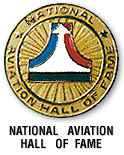 |
To visit his entry on this site, first click on National Aviation Hall of Fame to go to the homepage. Next, highlight and click on "Enshrinees List" at the lower left corner of the page. You will find an alphabetical listing of all enshrinees on this page. Then highlight and click on his name. |
|
If time permits, I heartily recommend that you visit the homepage and plan to spend some time on this wonderful site. |
|
Benjamin D. Foulois was elected to be an Honorary Fellow of the Society in 1962. You can access this site by clicking on: Benjamin D. Foulois You may want to use the "Find" function on "Foulois" I invite you to browse the site for other familiar names |
|
MEXICAN PUNITIVE EXPEDITION, 1916 By Capt. Benjamin D. Foulois, Signal Corps, U.S. Army Harold and many other Early Birds are mentioned in this story. You can access it by clicking on: First Aero Squadron |
|
Highly Recommended Books for Further Reading:
CONTACT: The Story of the Early Birds by Henry Serrano Villard Thomas Y. Crowell Company JENNY WAS NO LADY: The Story of the JN-4D by Jack R. Lincke W. W. Norton & Company, Inc. |
|
Highly Recommended Links for Further Reading:
BIOGRAPHY: United States Airforce. |
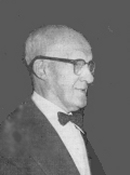 |
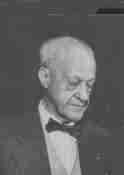 |
|
|
|
|
Major General Benjamin D. Foulois, at the time of his death at Andrews Air Force Base near Washington, D.C., on April 26, 1967
(aged eighty-seven), was engaged in writing down his recollections as the country's oldest military pilot |


|